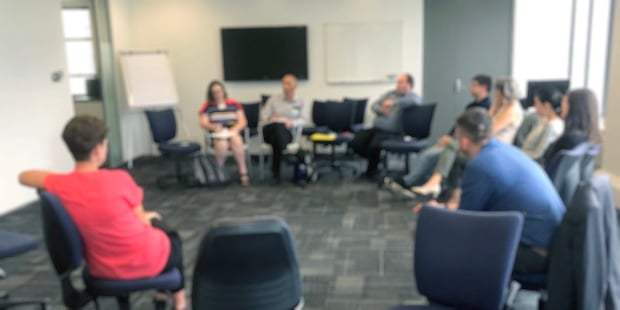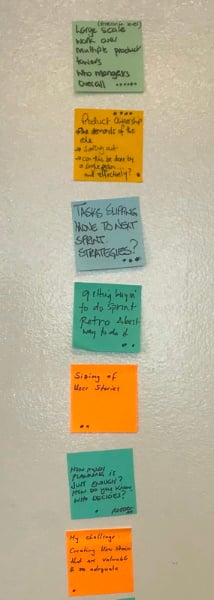Share this
Who manages the overall product picture? - Certified Scrum Meetup
by Brendon Livingstone on 21 February 2020

Last week Equinox IT hosted another Certified Scrum Meetup event in our Wellington offices. The event was facilitated by Principal Consultant Kirstin Donaldson and was run using a Lean Coffee format.
 This time we used a Trello board to capture some questions and challenges before the event, as well as people raising new questions and challenges on post-it notes. The group then discussed the highest 'dot voted' questions and challenges.
This time we used a Trello board to capture some questions and challenges before the event, as well as people raising new questions and challenges on post-it notes. The group then discussed the highest 'dot voted' questions and challenges.
The discussion for each of the highest 'dot voted' questions and challenges is summarised in the notes below.
For large-scale work over multiple products, who manages the overall picture?
Discussion included:
- Scrum of Scrums and Large Scale Scrum (LeSS)
- Having a Head / Chief of Product
- Starting a with Epics, and using a visual Epic board.
Can the demands of a Product Owner role be done effectively by a single person?
The person who raised this question was exploring having multiple Product Owners per team, one who could bring a business stakeholder perspective, one a technical specialist perspective and one a project manager perspective. Group discussion included:
- If the approach works for the team then keep going, if not inspect and adapt to something that does work
- The Product Owner role is the business stakeholder perspective, and the technical perspective is represented in Scrum by the Scrum Team and the project manager perspective is represented in Scrum by the ScrumMaster role.
What to do when documentation tasks keep rolling over from one sprint to the next?
Discussion included:
- Chunking working during sprint planning so that the work can fit within a sprint - for documentation, a large amount of documentation needs to be broken into smaller chunks and delivered incrementally
- Include documentation within the 'definition of done' for product user stories, so that documentation is delivered together with product features and the feature is not completed until it is also documented
- If need to catch-up on a substantial amount of documentation, potentially run a sprint that is dedicated to documentation to get this completed
- Work generally shouldn't roll over from one sprint to another, and if it does, then potentially there is too much work being committed to and too much work in progress per sprint.
How to get buy-in to do sprint retrospectives?
The person who raised this question said that the team is very busy delivering and it is a struggle to get these people together for a sprint retrospective. Group discussion included:
- Make it more attractive to meet, perhaps have just a 15 minute retrospective
- Book retrospectives early, as part of the regular and expected team process
- Include retrospectives as a team commitment in a working agreement
- Put retrospectives on the backlog as a work item that needs to be delivered
- This issue may also be a symptom of conditions that mean the team is not able to work in Agile ways - e.g. the team is over committed, has too much work in progress, or is not dedicated to one project
- Use a physical kanban board so that work and 'too much work' is visible.
Ideas for sizing of user stories
Discussion included:
- Use t-shirt sizing XS, S, M, L, XL, XXL so that is is more abstract - then apply numbers after, e.g. XS = 1, S = 2, M = 3, L = 5, XL = 8, XXL = 13
- Dog breed sizes (e.g. Rottweiler vs Chihuahua) or fish sizes (e.g. Hammerhead vs Goldfish); can pick a subject suited to the team and this also helps create a better team culture.
How much planning is just enough? How do you know who decides?
Discussion included:
- Start with Epics, and use t-shirt sizing at the next level up, applicable to Epics. Apply Epic points on a larger time scale.
- If team is new to Agile look back at what has been achieved in the past to get a gauge for velocity - then learn and adapt from there
- Use consistent Epic / User Story templates to allow comparison for sizing - potentially co-create the template with the product owners.
How do you create user stories that are valuable and adequate?
The person who raised this question said that the team is really busy and doesn't have the patience to work on user stories. Group discussion included:
- Focus on user stories being a promise for a later conversation, so that story writing is not a prohibitively large task
- Use a good user story template
- Stick to good user story practice "As a user I want..."
- Use tight acceptance criteria
- Undertake really good backlog refining (and thus only need to put effort into priority user stories)
- Timebox each user story, say 10 minutes per story
- Use the 'three amigos' for user stories, representing product ownership, user experience and technical delivery, so that other team members are free to continue with other work.
We plan to host another Certified Scrum Meetup in March.
Share this
- Agile Development (153)
- Software Development (126)
- Agile (76)
- Scrum (66)
- Application Lifecycle Management (50)
- Capability Development (47)
- Business Analysis (46)
- DevOps (43)
- IT Professional (42)
- Equinox IT News (41)
- Agile Transformation (38)
- IT Consulting (38)
- Knowledge Sharing (36)
- Lean Software Development (35)
- Requirements (35)
- Strategic Planning (35)
- Solution Architecture (34)
- Digital Disruption (32)
- IT Project (31)
- International Leaders (31)
- Digital Transformation (26)
- Project Management (26)
- Cloud (25)
- Azure DevOps (23)
- Coaching (23)
- IT Governance (23)
- System Performance (23)
- Change Management (20)
- Innovation (20)
- MIT Sloan CISR (15)
- Client Briefing Events (13)
- Architecture (12)
- Working from Home (12)
- IT Services (10)
- Data Visualisation (9)
- Kanban (9)
- People (9)
- Business Architecture (8)
- Communities of Practice (8)
- Continuous Integration (7)
- Business Case (4)
- Enterprise Analysis (4)
- Angular UIs (3)
- Business Rules (3)
- Java Development (3)
- Lean Startup (3)
- Satir Change Model (3)
- API (2)
- Automation (2)
- GitHub (2)
- Scaling (2)
- Toggles (2)
- .Net Core (1)
- Diversity (1)
- Security (1)
- Testing (1)
- February 2024 (3)
- January 2024 (1)
- September 2023 (2)
- July 2023 (3)
- August 2022 (4)
- August 2021 (1)
- July 2021 (1)
- June 2021 (1)
- May 2021 (1)
- March 2021 (1)
- February 2021 (2)
- November 2020 (2)
- September 2020 (1)
- July 2020 (1)
- June 2020 (3)
- May 2020 (3)
- April 2020 (2)
- March 2020 (8)
- February 2020 (1)
- November 2019 (1)
- August 2019 (1)
- July 2019 (2)
- June 2019 (2)
- April 2019 (3)
- March 2019 (2)
- February 2019 (1)
- December 2018 (3)
- November 2018 (3)
- October 2018 (3)
- September 2018 (1)
- August 2018 (4)
- July 2018 (5)
- June 2018 (1)
- May 2018 (1)
- April 2018 (5)
- March 2018 (3)
- February 2018 (2)
- January 2018 (2)
- December 2017 (2)
- November 2017 (3)
- October 2017 (4)
- September 2017 (5)
- August 2017 (3)
- July 2017 (3)
- June 2017 (1)
- May 2017 (1)
- March 2017 (1)
- February 2017 (3)
- January 2017 (1)
- November 2016 (1)
- October 2016 (6)
- September 2016 (1)
- August 2016 (5)
- July 2016 (3)
- June 2016 (4)
- May 2016 (7)
- April 2016 (13)
- March 2016 (8)
- February 2016 (8)
- January 2016 (7)
- December 2015 (9)
- November 2015 (12)
- October 2015 (4)
- September 2015 (2)
- August 2015 (3)
- July 2015 (8)
- June 2015 (7)
- April 2015 (2)
- March 2015 (3)
- February 2015 (2)
- December 2014 (4)
- September 2014 (2)
- July 2014 (1)
- June 2014 (2)
- May 2014 (9)
- April 2014 (1)
- March 2014 (2)
- February 2014 (2)
- December 2013 (1)
- November 2013 (2)
- October 2013 (3)
- September 2013 (2)
- August 2013 (6)
- July 2013 (2)
- June 2013 (1)
- May 2013 (4)
- April 2013 (5)
- March 2013 (2)
- February 2013 (2)
- January 2013 (2)
- December 2012 (1)
- November 2012 (1)
- October 2012 (2)
- September 2012 (3)
- August 2012 (3)
- July 2012 (3)
- June 2012 (1)
- May 2012 (1)
- April 2012 (1)
- February 2012 (1)
- December 2011 (4)
- November 2011 (2)
- October 2011 (2)
- September 2011 (4)
- August 2011 (2)
- July 2011 (3)
- June 2011 (4)
- May 2011 (2)
- April 2011 (2)
- March 2011 (3)
- February 2011 (1)
- January 2011 (4)
- December 2010 (2)
- November 2010 (3)
- October 2010 (1)
- September 2010 (1)
- May 2010 (1)
- February 2010 (1)
- July 2009 (1)
- April 2009 (1)
- October 2008 (1)